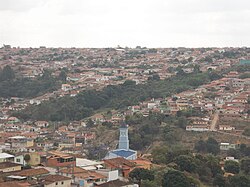Capelinha
| Capelinha | ||
|---|---|---|
| Municipality | ||
|
Município de Capelinha Municipality of Capelinha |
||
 |
||
|
||
| Nickname(s): Suíça Brasileira (Brazilian Switzerland) and Capela City | ||
 |
||
| Location in Brazil | ||
| Coordinates: 17°41′27″S 42°30′57″W / 17.69083°S 42.51583°WCoordinates: 17°41′27″S 42°30′57″W / 17.69083°S 42.51583°W | ||
| Country |
|
|
| Region | Southeast | |
| State |
|
|
| Founded | February 24, 1913 | |
| Government | ||
| • Mayor | Zezinho da Vitalina (2013–2017) |
|
| Area | ||
| • Total | 965.901 km2 (372.936 sq mi) | |
| Elevation | 900 m (3,000 ft) | |
| Population (2011) | ||
| • Total | 36.740(List of largest cities in Brazil) | |
| Demonym(s) | Capelinhense | |
| Time zone | BRT (UTC−3) | |
| • Summer (DST) | BRST (UTC−2) | |
| Postal Code (CEP) | 39680000 | |
| Website | www |
|
Capelinha is a Brazilian municipality located in the north-center of the state of Minas Gerais. Its population as of 2013 was 36,740 living in a total area of 966 km². The city belongs to the statistical mesoregion of Jequitinhonha and to the statistical microregion of Capelinha. It became a municipality in 1913.
Capelinha is located at an elevation of 1100 meters between the Itamarandiba and the Fanado Rivers, both of which flows north into the Jequitinhonha River. It is northeast of Diamantina and Itamarandiba.Highway access is made by BR-381, MG-434, BR-120, and MG-129.
The distance to Diamantina is 176 km; Teófilo Otoni is 190 km;Itamarandiba is 63; Km; and the distance to Belo Horizonte is 427 km. Neighboring municipalities are: Veredinha, Turmalina, Itamarandiba, Aricanduva, Minas Novas, Água Boa, Setubinha, and Angelândia.
The main economic activities are services, agriculture, and small industries. The planting of eucalyptus for charcoal production is important and coffee cultivation has been increasing in recent years. The GDP in 2005 was R$141 million, with 83 million from services, 10 million from industry, and 40 million from agriculture. There were 1,344 rural producers on 40,000 hectares of land. Only 93 farms had tractors (2006). The main crops were eucalyptus, sugarcane, coffee (8,860 hectares), beans, and corn (1,900 hectares). There were 13,000 head of cattle (2006). In 2007 there were 3 banks.
...
Wikipedia


